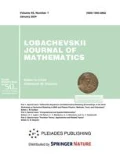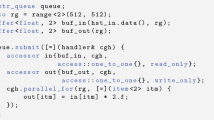Abstract
The paper is devoted to the evaluation of energy efficiency of High Performance Computing systems used in a scientific supercomputer center. The authors propose a method for the comparison of energy efficiency of computing systems based on the power consumption and execution time of parallel programs. The paper presents a software tool that allows to determine the energy consumption profile of a parallel program automatically without changing its source code. The paper also presents the results of power consumption comparison of NAS Parallel Benchmarks (BT, EP, IS, and LU) tests on computing systems with codenames Intel microprocessors Broadwell, Cascade Lake, Knights Landing and Skylake).






Similar content being viewed by others
REFERENCES
G. I. Savin, B. M. Shabanov, P. N. Telegin, and A. V. Baranov, ‘‘Joint supercomputer center of the Russian Academy of Sciences: Present and future,’’ Lobachevskii J. Math. 40 (11), 1853–1862 (2019). https://doi.org/10.1134/S1995080219110271
Y. Chen, S. Alspaugh, D. Borthakur, and R. Katz, ‘‘Energy efficiency for large-scale MapReduce workloads with significant interactive analysis,’’ in Proceedings of the 7th ACM European Conference on Computer Systems EuroSys 12 (2012), pp. 43–56. https://doi.org/10.1145/2168836.2168842
N. Tiwari, S. Sarkar, U. Bellur, and M. Indrawan, ‘‘An empirical study of hadoop’s energy efficiency on a HPC cluster,’’ Proc. Comput. Sci. 29, 62–72 (2014). https://doi.org/10.1016/j.procs.2014.05.006
E. A. Kiselev, A. V. Baranov, and S. A. Leshchev, ‘‘Comparative analysis of approaches and methods for measuring the power consumption of computer systems,’’ in Proceedings of the ITHPC-2019 5th International Conference Information Technologies and High-Performance Computing, Khabarovsk, Russia (2019), pp. 66–71.
A. Noureddine, R. Rouvoy, and L. Seinturier, ‘‘A review of energy measurement approaches,’’ Operat. Syst. Rev., Assoc. Comput. Mach. 47 (3), 42–49 (2013). https://doi.org/10.1145/2553070.2553077
C. Lively, V. Taylor, W. Wu, H. Chang, C. Su, K. Cameron, S. Moore, and D. Terpstra, ‘‘E-AMOM: An energy-aware modeling and optimization methodology for scientific applications on multicore systems,’’ Comp. Sci.–Res. Dev. 29, 197–210 (2014). https://doi.org/10.1007/s00450-013-0239-3
S. Walker and M. McFadden, ‘‘Best practices for scalable power measurement and control,’’ in Proceedings of the IEEE International Parallel and Distributed Processing Symposium Workshops (IPDPSW), Chicago, IL (2016), pp. 1122–1131. https://doi.org/10.1109/IPDPSW.2016.91
X. Wu and V. Taylor, ‘‘Utilizing hardware performance counters to model and optimize the energy and performance of large scale scientific applications on power-aware supercomputers,’’ in Proceedings of the IEEE International Parallel and Distributed Processing Symposium Workshops (IPDPSW), Chicago, IL (2016), pp. 1180–1189. https://doi.org/10.1109/IPDPSW.2016.78
C. Lively, X. Wu, V. Taylor, S. Moore, H.–C. Chang, and K. Cameron, ‘‘Energy and performance characteristics of different parallel implementations of scientific applications on multicore systems,’’Int. J. High Perform. Comput. Appl. 25, 342–350 (2011). https://doi.org/10.1177/1094342011414749
D. Li, B. R. de Supinski, M. Schulz, K. Cameron, and D. S. Nikolopoulos, ‘‘Hybrid MPI/OpenMP power-aware computing,’’ in Proceedings of the IEEE International Symposium on Parallel & Distributed Processing (IPDPS), Atlanta, GA (2010), pp. 1–12. https://doi.org/10.1109/IPDPS.2010.5470463
NVIDIA Management Library (NVML). https://developer.nvidia.com/nvidia-management-library-nvml. Accessed May 18, 2020.
A. Reuther et al., ‘‘Scalable system scheduling for HPC and big data,’’ J. Parallel Distrib. Comput.111, 76–92 (2018). https://doi.org/10.1016/j.jpdc.2017.06.009
A. B. Yoo, M. A. Jette, and M. Grondona, ‘‘SLURM: Simple Linux utility for resource management,’’ Lect. Notes Comput. Sci. 2862, 44–60 (2003). https://doi.org/10.1007/10968987_3
R. L. Henderson, ‘‘Job scheduling under the Portable Batch System,’’ Lect. Notes Comput. Sci. 949, 279–294 (1995). https://doi.org/10.1007/3-540-60153-8_34
IBM Spectrum LSF Overview. https://www.ibm.com/support/knowledgecenter/en/SSWRJV_10.1.0/ lsf_foundations/chap_lsf_overview_foundations.html. Accessed May 13, 2020.
Supercomputing Resources of JSCC RAS. http://www.jscc.ru/supercomputing-resources/. Accessed May 12, 2020.
Funding
The work was carried out at the JSCC RAS as part of the state assignment. Supercomputer MVS-10P OP was used.
Author information
Authors and Affiliations
Corresponding authors
Additional information
(Submitted by A. M. Elizarov)
Rights and permissions
About this article
Cite this article
Kiselev, E.A., Kiselev, V.I., Shabanov, B.M. et al. The Energy Efficiency Evaluating Method Determining Energy Consumption of the Parallel Program According to Its Profile. Lobachevskii J Math 41, 2542–2551 (2020). https://doi.org/10.1134/S1995080220120161
Received:
Revised:
Accepted:
Published:
Issue Date:
DOI: https://doi.org/10.1134/S1995080220120161




